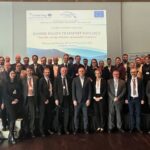Policy-project-cycle, process, ongoing since 2014
Submitted by / EUSDR Priority Area(s): PA 1a Waterways Mobility
Unstable and unpredictable fairway conditions along the Danube lead to cargo vessels that are not optimally loaded. This results in unreliable logistics chains and transport prices per transported tonne that are too high to be competitive. For the passenger shipping industry, unstable fairway conditions may prevent voyages from being carried out as planned, resulting in additional costs for cruise operators and an overall loss of image. Apart from structural river engineering-works on a limited number of strategic waterway bottlenecks, proper fairway maintenance helps in securing stable fairway conditions for waterway operators and their customers.
In response to inadequate fairway conditions along the Danube, Priority Area 1a, together with the waterway administrations and Ministries of Transport of the Danube Region, elaborated the Fairway Rehabilitation and Maintenance Master Plan for the Danube and its navigable tributaries (FRMMP) in 2014. The Master Plan stipulates a target minimum Level of Service of mostly 2.5m fairway depth along the Danube waterway (at Low Navigable Water Level) and defines – for each riparian state – the most important issues that need to be addressed to improve fairway rehabilitation and maintenance activities in order to eventually reach this target depth. The waterway management authorities have also estimated their needed annual operational budgets and listed needed investments for dredging equipment, riverbed surveying and fairway marking equipment.
The FRMMP thus provides a strategic framework for coordinated, concerted action to establish stable fairway conditions along the entire Danube and its navigable tributaries. It was endorsed by 10 riparian states during the Danube Ministers Meeting in Brussels on 3 December 2014. In order to keep the topic of fairway rehabilitation and maintenance on the political agenda of the Danube riparian countries and to regularly obtain a renewed commitment of the Danube Ministers of Transport to the Master Plan, Priority Area 1a in cooperation with DG MOVE organises a meeting of the Danube Ministers of Transport every two years, where Danube Ministerial Conclusions are signed and the implementation of the Master Plan is reaffirmed again and again. After 2014, such meetings were held in 2016, 2018, 2020 and 2022, where an updated version of the master plan was endorsed.
As with any strategy, the document itself does not change anything; projects are needed on the ground to implement it. After 2014, a number of national and also some transnational projects were initiated by the Master Plan, the best known and largest implementation project of the Master Plan was the FAIRway Danube project (2015 – 2021). In recent years, through such projects and with the help of EU co-funding, viable investments have been made that support the waterway administrations of the Danube Region in their maintenance and rehabilitation tasks.
EUSDR PA 1a regularly monitors the implementation status of the Master Plan and on the one hand supports the waterway authorities in the implementation of the Master Plan and on the other hand organises the political support of the Danube Ministers of Transport and the awareness of the necessary financial means through the Danube Ministerial meetings and the signing of Danube Ministerial Conclusions which take place every two years. This policy-project-cycle has proved successful in the past and will be continued by PA 1a.
Objectives
The overall objective is to establish stable and reliable fairway conditions along the entire Danube and its navigable tributaries of mostly 2.5m fairway depth at Low Navigable Water Level.
Need and (expected) impact
The current situation includes unstable fairway conditions – a situation that needs to be changed as soon as possible.
Macro-regional dimension
Countries involved in this process are those Danube Region countries with international waterways: Germany, Austria, Slovakia, Hungary, Croatia, Serbia, Bosnia and Hercegovina, Romania, Bulgaria, Republic of Moldova and Ukraine. As the aim is to establish stable and reliable fairway conditions along the entire waterway corridor, all countries need to be equally involved.
Stakeholders involved
Waterway administrations (waterway managers) of the Danube Region and Ministries of Transport (mostly PA 1a Steering Group members) of the Danube Region. The process is intensively supported by DG MOVE.
Budget and Funding
The process itself needs no funding other than the support the EUSDR Priority Area Coordinators (PACs) are receiving. This task is part of the coordination activities of the PA 1a Coordinators.
Further information:
https://navigation.danube-region.eu/working-groups/wg-1-waterway-infrastructure-management/
Contact

>> Download Certificate 2022 <<
>> Download Certificate 2023 <<


